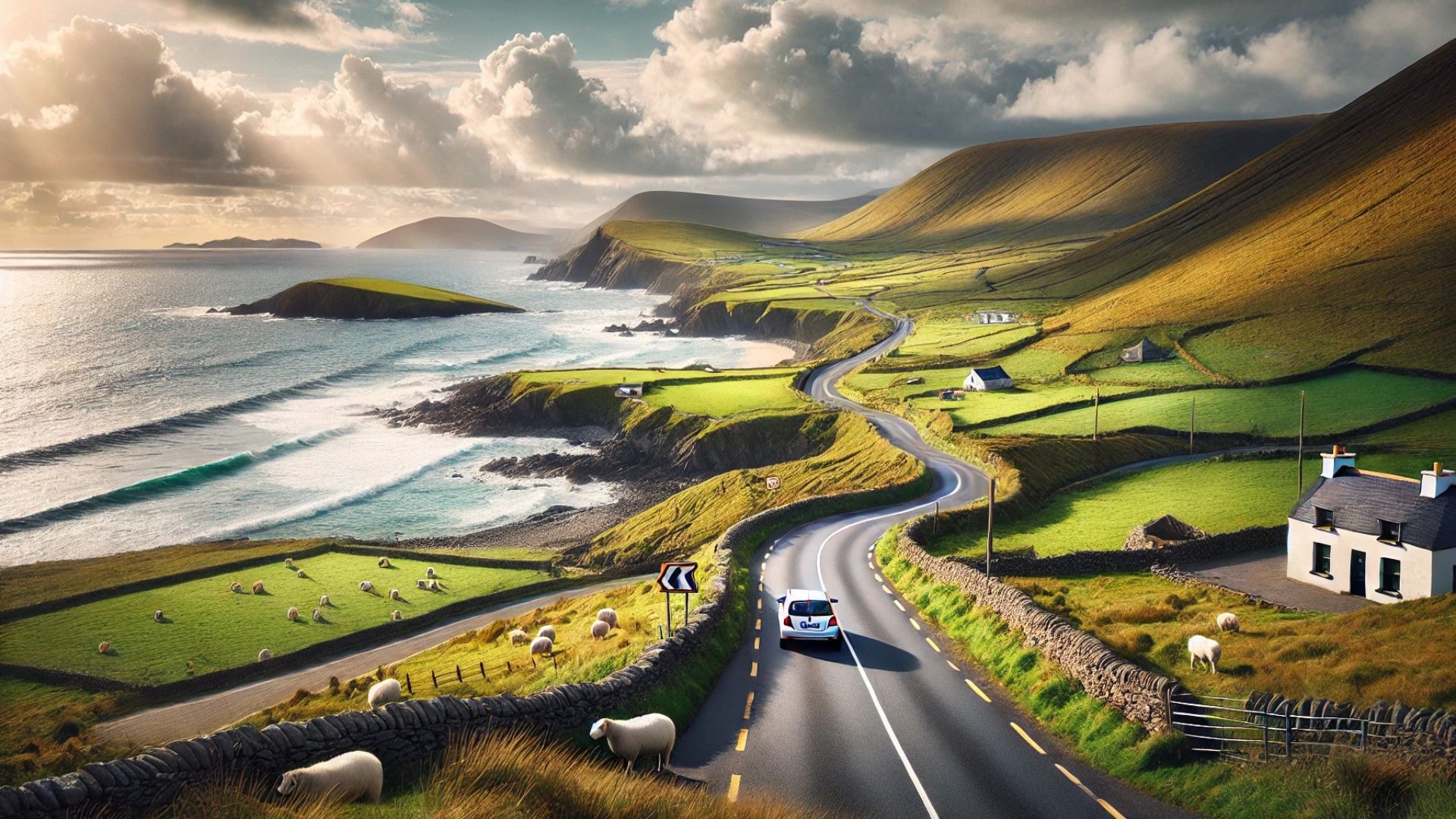
Slea Head Drive is one of Ireland's most scenic routes, located on the breathtaking Dingle Peninsula in County Kerry. This 30-mile (48 km) circular drive offers stunning coastal views, historical landmarks, and charming villages. Along the way, you’ll encounter must-see stops like the Blasket Islands Viewpoint, Dunquin Pier, and the Gallarus Oratory. Ideal for a leisurely road trip, the drive typically takes 3-4 hours, but can be extended depending on how much time you spend at each location.
I remember driving along Slea Head Drive last summer, and it was absolutely magical. We pulled over at almost every viewpoint, soaking in the ocean breeze and snapping photos of the rugged cliffs. My favorite moment was stopping at Dunquin Pier, where the waves crashed against the shore as we watched the sunset over the Atlantic—an experience I'll never forget.
| Stop | Description | Estimated Time | Tips |
|---|---|---|---|
| Blasket Islands Viewpoint | Offers stunning views of the Blasket Islands. | 15-30 minutes | Visit during clear weather for the best views. |
| Dunquin Pier | A picturesque pier with beautiful coastal scenery. | 20-30 minutes | Great spot for photos, especially at sunset. |
| Gallarus Oratory | An ancient stone church dating back to the 12th century. | 30 minutes | Check for guided tours for a deeper understanding. |
| Slea Head Beach | A beautiful sandy beach perfect for a relaxing break. | 30-60 minutes | Ideal for a picnic or a short walk. |
| Ventry Beach | A long stretch of sandy beach, popular for walking and surfing. | 30-60 minutes | Watch for local surfers; great for beachcombing. |
| Clogher Head | Offers breathtaking views and a chance to see wildlife. | 30 minutes | Keep an eye out for seals and seabirds. |
| Kilmalkedar Church | A historic site with ancient carvings and ruins. | 30 minutes | Don’t miss the Ogham stone and the early Christian cross. |
| Ballyferriter Village | A charming village with local shops and cafes. | 30-45 minutes | Stop for refreshments or to browse local crafts. |
| The Beehive Huts | Traditional stone huts used by early settlers. | 20-30 minutes | Explore the area and learn about its history. |
| An Ghaeltacht | A Gaeltacht area where Irish is the primary language spoken. | Varies | Immerse yourself in the local culture and language. |
What Is Slea Head Drive?
Slea Head Drive is a scenic route located on the Dingle Peninsula in County Kerry, Ireland. This renowned road stretches over 47 kilometers, offering breathtaking views of the Atlantic Ocean, rugged coastlines, and rolling green hills. Renowned for its rich history, the drive passes through areas dotted with ancient archaeological sites like beehive huts, Iron Age monuments, and early Christian chapels.
Travelers embarking on this journey will encounter some of Ireland's most picturesque villages, including Ventry, Dunquin, and Ballyferriter, each offering unique insights into the traditional Irish way of life. Slea Head Drive also provides access to several famous landmarks, such as the Blasket Islands Visitor Centre, which tells the story of the unique community that once lived on the now-uninhabited islands.
Ideal for a day trip, this route is best experienced by car or bike, allowing for stops at various lookouts and cultural sites. It is particularly popular for its dramatic sunsets and as a prime spot for photography, capturing the essence of Ireland's stunning natural beauty.
Why Is Slea Head Drive Famous?
Slea Head Drive is famous for its breathtaking landscapes and rich historical significance. This scenic route on the Dingle Peninsula in County Kerry, Ireland, offers some of the most stunning views of the Atlantic Ocean, rugged cliffs, and pristine beaches. It's not only a feast for the eyes but also a journey through time, with numerous ancient sites along the way that tell tales of Ireland's early inhabitants.
Travelers and photography enthusiasts are drawn to Slea Head Drive for its dramatic scenery and the opportunity to experience the quintessential Irish coastal landscape. Each twist and turn along the drive reveals new vistas and historic sites, making it a must-visit destination for anyone exploring Ireland.
Panoramic Ocean Views
Slea Head Drive is renowned for its spectacular ocean views that stretch far into the horizon. The road skirts along the edge of the peninsula, providing continuous opportunities to gaze out at the vast Atlantic Ocean. These views are especially mesmerizing at sunset when the sky and sea are aflame with colors.
-
Viewing Points: There are numerous spots along the route where travelers can stop to enjoy uninterrupted views of the ocean, making it perfect for scenic photography and peaceful contemplation.
-
Blasket Islands: Visible from the drive, these islands offer a stunning backdrop, particularly known for their evocative history and the abandoned village that speaks of a once-thriving community.
Rich Historical Sites
The drive is dotted with important historical sites that offer a glimpse into Ireland's ancient past. From beehive huts that date back over a thousand years to standing stones and the ruins of early Christian chapels, Slea Head Drive serves as a live museum of Irish history.
-
Gallarus Oratory: This small but perfectly preserved stone building is thought to have been a religious site, demonstrating the sophistication of early Christian architecture in Ireland.
-
Dunbeg Fort: An impressive example of an Iron Age promontory fort, featuring defensive structures that show the strategic use of natural landscape to protect against invaders.
Unique Cultural Experience
Visitors to Slea Head Drive can immerse themselves in the Gaeltacht, or Irish-speaking areas, where traditional Irish culture and language thrive. It's an area that celebrates Irish heritage with music, dance, and festivals that are deeply rooted in the local community.
-
Local Crafts: Engage with artisans who maintain traditional crafts like basket weaving and lace making, offering insights into the cultural practices that have shaped the local community.
-
Cultural Festivals: Experience the vibrant local festivals that feature traditional Irish music, dance, and language, providing a deep dive into the cultural heart of the Gaeltacht.
Stunning Film Locations
Slea Head Drive has been a favored location for filmmakers due to its unspoiled natural beauty. It has featured in several films, including the famous "Star Wars: The Last Jedi," which has added to its appeal and fame, drawing movie fans and tourists alike to this picturesque location.
-
Star Wars Filming Sites: Discover the exact locations where scenes from "Star Wars: The Last Jedi" were filmed, adding a layer of cinematic magic to the landscape.
-
Film Enthusiast Tours: Participate in tours that focus on the drive’s role in cinema, providing behind-the-scenes insights into the movies shot in this stunning setting.
Slea Head Drive Stops
Here are some must-see stops along Slea Head Drive that highlight the beauty, history, and culture of the Dingle Peninsula:
1. Ventry Beach
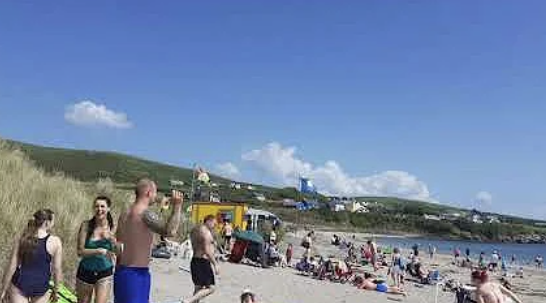
Start your journey with a visit to this long, sandy beach ideal for a relaxing stroll. It’s a great spot to enjoy the sea breeze and take in the stunning coastal views.
2. Dunbeg Fort
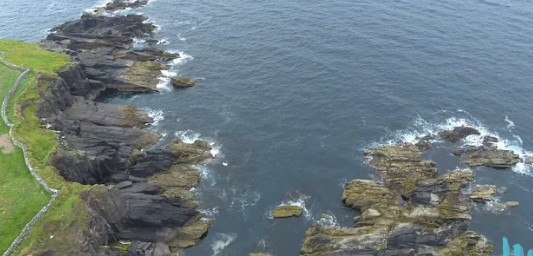
This ancient promontory fort, dating back to the Iron Age, sits on the edge of a cliff and offers a glimpse into Ireland’s past. It’s an incredible spot to explore and photograph the rugged coastline.
3. Beehive Huts (Clocháns)
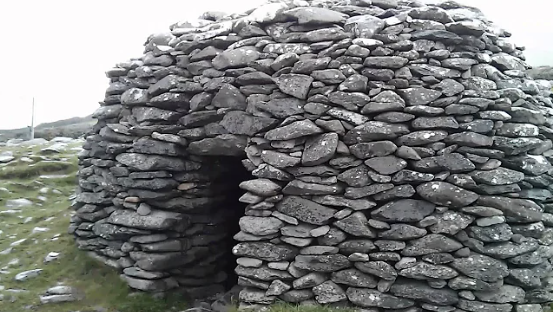
These well-preserved stone huts, believed to be over 1,000 years old, showcase the traditional architecture of early settlers. They offer a fascinating insight into ancient Irish life.
4. Slea Head Viewpoint
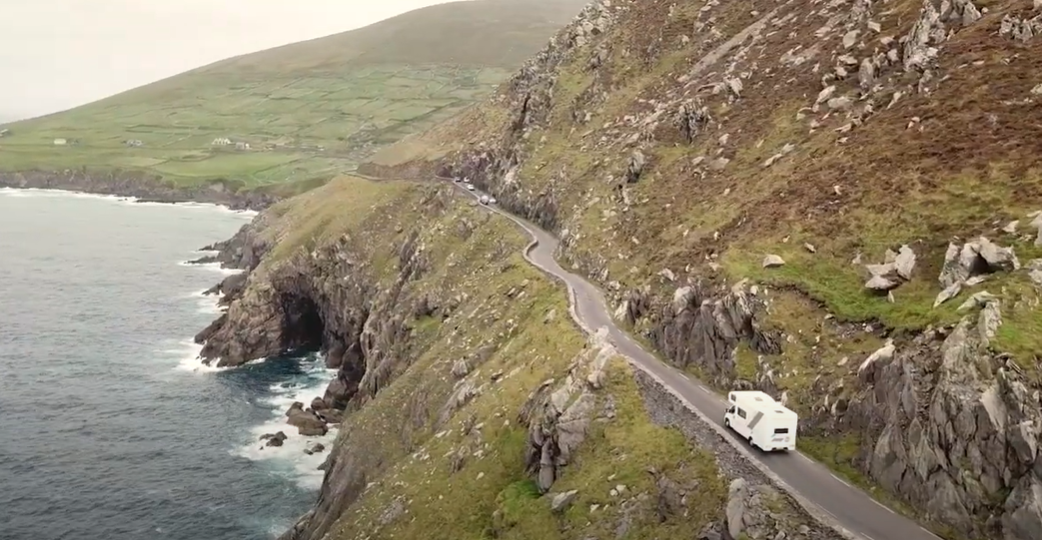
One of the most iconic viewpoints along the route, this stop provides panoramic views of the Blasket Islands and the vast Atlantic Ocean. It’s a perfect place for a photo break!
5. Coumeenoole Beach
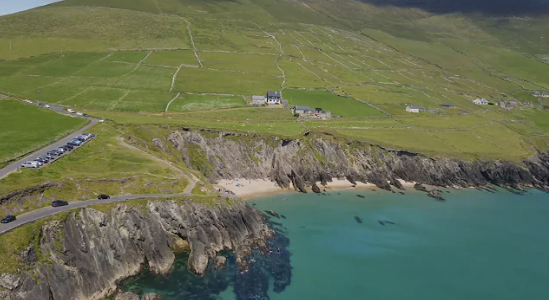
A beautiful and secluded beach, Coumeenoole is known for its dramatic cliffs and golden sands. It’s also famous for being a filming location for Ryan’s Daughter.
6. Blasket Islands Viewpoint
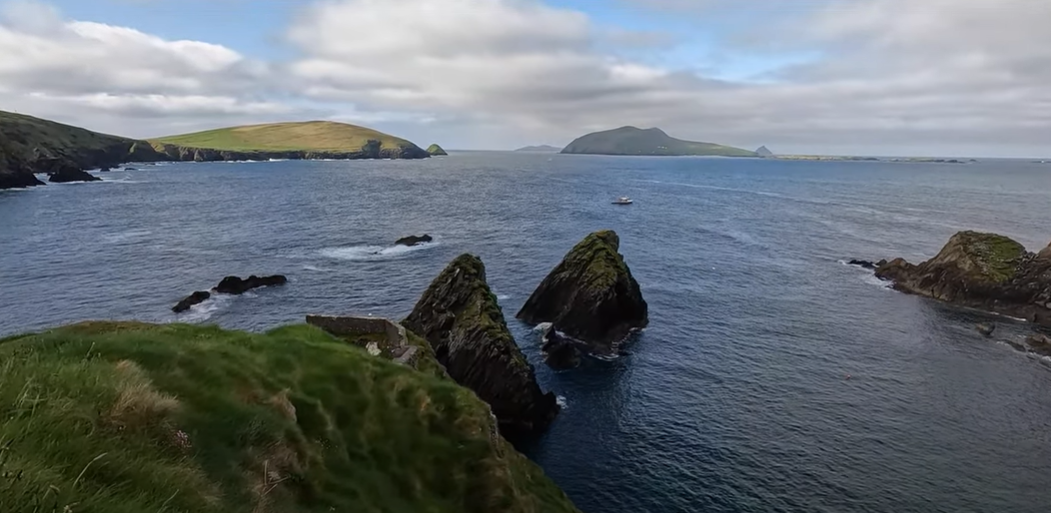
A stunning overlook where you can admire the Blasket Islands, this spot offers breathtaking vistas and an opportunity to learn about the islanders who once lived there.
7. Dunquin Pier
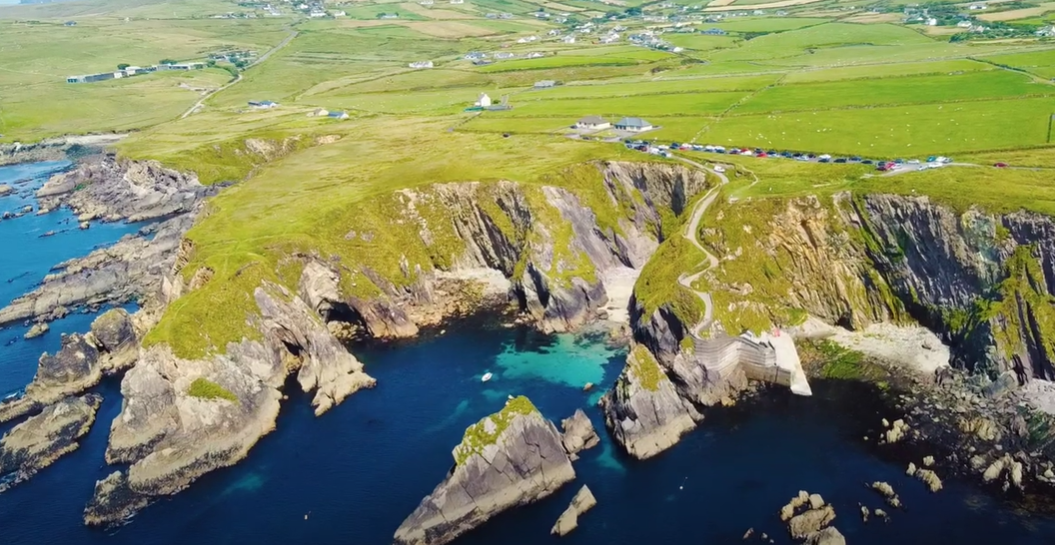
One of the most picturesque and photographed spots along Slea Head Drive, Dunquin Pier is a winding pathway that leads to a small harbor. It’s an excellent place to watch the waves crash against the cliffs.
8. Gallarus Oratory
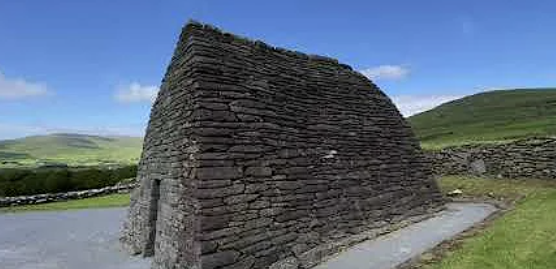
This early Christian church is a marvel of ancient architecture, constructed entirely of dry stone. The oratory has stood for over a thousand years and remains remarkably intact.
9. Ballyferriter Village
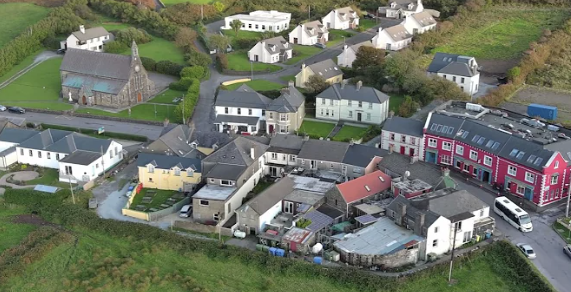
A quaint village where you can experience authentic Irish culture, Ballyferriter is perfect for a quick stop at a local pub or café. You can also visit the Músaem Chorca Dhuibhne (West Kerry Museum) to learn more about the region.
10. Ceann Sibéal (Sybil Head)
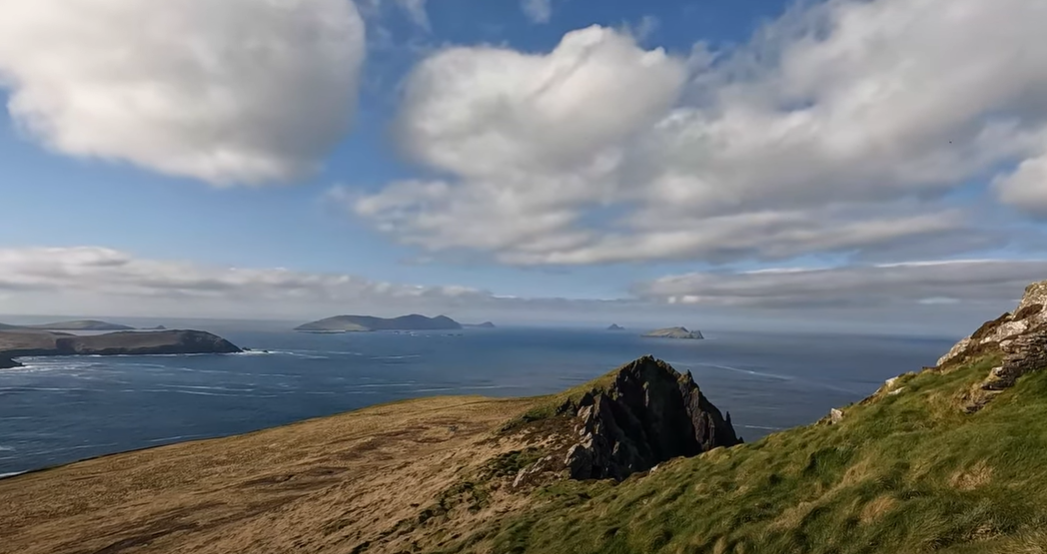
This dramatic headland offers panoramic views and is known as a filming location for Star Wars: The Last Jedi. It’s a fantastic spot for hiking and enjoying the rugged landscape.
Is Slea Head Drive One Way?
No, Slea Head Drive is not officially a one-way route, but it is recommended to drive it in a clockwise direction. This suggestion is mainly for safety and convenience, as the roads are narrow and winding, often hugging the cliffs along the coast. By driving clockwise, you’ll be on the inside lane closer to the mountainside, reducing the risk when passing oncoming traffic and allowing for easier stops at viewpoints and attractions. This direction also provides the best flow for sightseeing, making it the most enjoyable way to experience the stunning scenery along the route.
Top Attractions Along Slea Head Drive
Top attractions along Slea Head Drive include Dunmore Head, Coumeenoole Beach, Gallarus Oratory, The Blasket Centre, and Beehive Huts. They showcase the breathtaking beauty of Ireland's western coastline with landmarks steeped in history and nature. This scenic route offers travelers a unique journey through Irish culture, history, and stunning landscapes, revealing why it's considered one of the most beautiful drives in the world.
Exploring Slea Head Drive means encountering dramatic sea cliffs, ancient sites, and picturesque views that connect deeply with Ireland's past and present. Each stop on this drive provides a distinctive glimpse into the natural and historical treasures that make the Dingle Peninsula a must-visit destination.
Dunmore Head
Dunmore Head offers panoramic views of the Blasket Islands and is the westernmost point of mainland Ireland. Its breathtaking sea cliffs and meadows provide perfect photo opportunities and a chance to experience untouched Irish scenery. The area is also known for its historical significance, featuring remnants of ancient dwellings and rare prehistoric sites.
Visitors are treated to a rugged landscape that has largely remained unchanged for centuries. The headland is an ideal spot for nature lovers and photographers seeking to capture the essence of Ireland's wild coastline.
-
Location: Westernmost point of mainland Ireland, providing unobstructed sunset views.
-
Accessibility: Accessible via a short hike from the nearby parking area, suitable for all ages.
-
Wildlife: Home to a variety of seabirds and marine life, making it a fantastic spot for bird watching.
After exploring the headland, visitors can relax and take in the vast Atlantic horizon that stretches infinitely. Dunmore Head not only captivates with its natural beauty but also serves as a silent witness to centuries of Irish history, offering a profound sense of connection to the past.
The walk along the cliffs gives a feeling of being at the edge of the world, where the sound of the ocean and the wind creates a mesmerizing harmony. It’s a place where one can truly feel the powerful force of nature and the tranquility it brings.
Coumeenoole Beach
Coumeenoole Beach is a stunning, secluded beach framed by rugged cliffs and accessible via a winding road that descends sharply towards the Atlantic. Famous for its appearance in the film "Ryan’s Daughter," the beach offers a dramatic landscape and powerful waves, making it ideal for photography and reflective solitude.
This small but mighty beach provides a sense of isolation and escape, perfect for those looking to get away from the hustle and bustle of tourist spots. The sound of the crashing waves against the cliffs offers a natural symphony for visitors.
-
Film History: Featured prominently in the 1970 movie "Ryan’s Daughter," which showcased its dramatic beauty to the world.
-
Activities: Ideal for walking, sea swimming, and rock pooling during low tide.
-
Geology: The surrounding cliffs and rock formations offer insights into the geological history of the Dingle Peninsula.
After a visit to Coumeenoole Beach, one cannot help but feel refreshed by the raw power and beauty of nature. The beach’s secluded location and cinematic history make it a unique stop on the Slea Head Drive that stays in memory long after leaving.
The area's natural beauty is complemented by its cinematic lore, making it a cultural and visual feast. It’s a must-visit for anyone seeking a deeper understanding of Ireland's natural landscapes and their impact on art and history.
Gallarus Oratory
The Gallarus Oratory, an early Christian church shaped like an upturned boat, stands as a remarkable example of dry-stone construction. Dating back over a thousand years, this well-preserved structure offers insights into the religious history of the area. Its simplicity and the mystery of its precise construction continue to draw visitors and historians alike.
Set against the stark landscape of the Dingle Peninsula, the Oratory is a testament to the ingenuity and faith of Ireland's early Christians. The site offers a peaceful and spiritual experience, isolated from modern distractions.
-
Architecture: Perfect example of dry-stone construction, with stones carefully fitted together without mortar.
-
Historical Significance: Believed to have been used as a place of worship by early Christians in the region.
-
Preservation: Remarkably well-preserved due to its architectural design, providing a direct link to Ireland's early Christian past.
Visiting the Gallarus Oratory is like stepping back in time. The structure’s small, enclosed space and its survival through the centuries offer a tangible connection to the past. It’s a reflective site that speaks volumes about the resilience and spirituality of its builders.
The oratory is surrounded by a serene landscape, making it a perfect spot for contemplation and appreciation of Ireland's rich history. The simplicity of the structure, combined with the complexity of its construction, fascinates academics and tourists alike, making it a profound educational and cultural experience.
The Blasket Centre
The Blasket Centre is a cultural museum dedicated to celebrating the life and literature of the Blasket Islands. It provides visitors with a profound insight into the unique community that once thrived on the remote islands off the coast of the Dingle Peninsula. The center highlights how isolation shaped their society and spurred a rich oral and written literary tradition, recognized worldwide.
By exploring the exhibits, visitors gain an understanding of the harsh living conditions and the extraordinary literary contributions of the islanders. The center uses multimedia presentations to bring stories of island life, emigration, and community spirit to life.
-
Exhibits: Features a range of interactive displays and rare photographs depicting daily life on the islands.
-
Literary Significance: Celebrates the works of renowned Blasket writers like Peig Sayers and Tomás Ó Criomhthain.
-
Viewpoint: Offers stunning views of the Blasket Islands, enhancing the cultural narrative with breathtaking scenery.
The Blasket Centre not only educates about a unique facet of Irish heritage but also connects visitors emotionally to the resilience of the Blasket Islanders. It serves as a reminder of how culture can thrive in even the most challenging environments.
In the center, every artifact and story piece is a testament to the indomitable spirit of the Blasket community. The blend of cultural heritage and panoramic views makes the Blasket Centre a key stop on the Slea Head Drive, offering both educational and aesthetic pleasure.
Beehive Huts
Beehive Huts, or Clocháns, are ancient stone huts with a distinctive beehive shape that dot the landscape of the Dingle Peninsula. These structures, dating back to as early as the 12th century, are remarkable examples of early Irish architecture using corbelled stone techniques without the use of mortar.
These huts provide visitors with a rare glimpse into the everyday lives of early Irish settlers. Their compact, rounded structures are a direct adaptation to the harsh weather conditions of the region, showcasing the ingenuity of their builders.
-
Construction: Built using the dry-stone technique, each stone carefully placed to support the next.
-
Historical Use: Likely used as temporary shelters by monks or small dwellings by early Irish farmers.
-
Preservation: Many huts have been restored to protect their structural integrity and historical value.
Visiting these huts offers a tangible connection to Ireland’s distant past, where simplicity and functionality were key to survival. The Beehive Huts are not just architectural relics; they are symbols of resilience and adaptation.
The serene setting and historical depth of these huts make them a captivating stop for those interested in Ireland's archaeological and cultural history. Their preservation allows future generations to appreciate the early human settlements of Ireland, making them an essential part of the Slea Head Drive Ireland experience.
How to Plan Your Slea Head Drive Tour?
Planning your Slea Head Drive tour requires thoughtful preparation to ensure you experience all the wonders of this scenic Slea Head Drive route on Ireland’s Dingle Peninsula drive. Start by determining the best time of year to visit. Ideally, late spring through early autumn offers the most favorable weather, avoiding the heavier tourist traffic of peak summer. Equip yourself with a reliable vehicle suitable for narrow, winding roads and ensure your driving skills are up to par for rural Irish driving conditions.
The Slea Head Drive starts at a legendary starting point along the entire Dingle Peninsula, guiding you through breathtaking landscapes. Be sure to include stops like Clogher Head, the Great Blasket Centre, and even consider hiking Mount Brandon for panoramic views. Using Google Maps can make it easier to navigate the Slea Head loop efficiently and enjoy your time without missing key attractions.
Next, decide on the duration of your drive. While Slea Head Drive can be completed in a day, extending your tour to two or three days allows for leisurely exploration of each site and a deeper connection with the local culture. Consider accommodations in Dingle town, which offers a variety of options from quaint B&Bs to luxurious hotels, providing a charming base from which to start and end your journey. And, if time permits, complement your experience with a drive along the renowned Ring of Kerry for even more scenic adventures.
-
Map Your Route: Obtain a detailed map of the peninsula and mark key attractions you wish to visit. Include famed spots like the Blasket Islands Visitor Centre and the ancient Beehive Huts.
-
Check Local Insights: Visit local tourism websites or contact visitor centers in Dingle for current information on road conditions and any cultural events that might coincide with your visit.
-
Plan for Stops: Allocate sufficient time for each major attraction. Don’t rush; the beauty of Slea Head is best appreciated at a leisurely pace.
-
Pack Essentials: Weather on the Atlantic can be unpredictable. Pack rain gear, comfortable walking shoes, and binoculars for bird watching and enjoying coastal views.
After completing your drive, take some time to review and share your experiences. Writing a blog post or an online review can help future travelers and provide feedback to local services. Reflect on the highlights of your trip and any unexpected discoveries that made your journey memorable. Additionally, consider visiting other parts of the Wild Atlantic Way to extend your adventure in Ireland, leveraging the knowledge and confidence you gained from driving the Slea Head route.
Finally, remember that every tour can be a learning opportunity. Consider what you would do differently next time and what tips you could offer to others planning their visit. Whether it’s finding the perfect spot for a sunset or choosing the best local eatery, your insights can enhance the journey for others. Embrace the spirit of discovery that Slea Head Drive nurtures in every traveler.
What is the Recommended Duration for the Drive?
The recommended duration for the Slea Head Drive is at least half a day. This iconic route in Ireland is renowned for its breathtaking views of the Atlantic Ocean, dramatic cliffs, and ancient heritage sites. Allocating a few hours lets you fully immerse in the picturesque landscapes and explore significant landmarks at a leisurely pace. To truly capture the essence of this unique experience, consider extending your journey to a full day. This allows time for spontaneous explorations, leisurely meals, and deeper engagement with the local culture and history.
Outdoor Activities Along the Slea Head Drive
Outdoor activities along the Slea Head Drive provide a perfect opportunity to immerse yourself in the wild and rugged landscapes of Ireland’s west coast. This iconic route is not just a drive; it's an invitation to adventure, offering a plethora of options for anyone keen to hike, take stunning photos, or just soak in breathtaking views. As you navigate the winding roads, you'll encounter various spots that showcase the unique landscapes and rich cultural heritage of the area, ensuring your journey is filled with memorable experiences.
The Slea Head Drive is a paradise for outdoor enthusiasts, offering a range of activities to suit different tastes and fitness levels. Whether you prefer leisurely strolls on sandy beaches or vigorous hikes up steep cliffs, there’s something here to engage your senses. The drive offers numerous ways to enjoy the serene beauty of the Dingle Peninsula, from bird watching and photography to simply sitting back and enjoying the tranquil surroundings. Prepare to explore diverse terrains, connect with nature, and create stories you’ll want to share.
Hiking the Blasket Islands
A trip to the Blasket Islands starts with a scenic ferry ride from the mainland, transporting you into a peaceful world of natural beauty and historical ruins. The islands feature a network of trails that take you through landscapes dotted with abandoned stone cottages and lush, untamed fields. As you hike, you'll enjoy uninterrupted views of the Atlantic Ocean, encounter local wildlife like seals and seabirds, and feel the mystical charm of these deserted islands. It's an introspective journey that connects you with the islands’ poignant history and the enduring power of nature.
-
Explore Ancient Ruins: Wander through the remnants of the island village and imagine life here centuries ago.
-
Wildlife Watching: Keep an eye out for native birds, seals lounging on the rocks, and maybe even dolphins off the coast.
-
Photography Opportunities: Capture the raw beauty of the islands’ landscapes and seascapes, perfect for any photography enthusiast.
Cycling Around Slea Head
Cycling around Slea Head is another excellent way to experience the area’s dramatic landscapes. Bike rentals are available at various points along the drive, catering to beginners and seasoned cyclists alike. The cycling route is marked by its gentle slopes and panoramic views, offering a leisurely yet intimate encounter with the peninsula’s cliffs and coastal scenes. Frequent stops for photos, snacks, or just to take in the view make cycling here a relaxed and enjoyable activity, allowing you to appreciate the beauty at your own pace.
-
Rent a Bike: Choose from various bike rental locations along the route for convenience.
-
Stop at Viewing Points: Take breaks at designated viewpoints to enjoy some of the best vistas on the peninsula.
-
Visit Local Cafés: Stop by small towns along the way for refreshments or a casual meal in a local café.
Beachcombing at Coumeenoole Beach
For those who love the sea, Coumeenoole Beach is a hidden gem along the Slea Head Drive. This secluded beach is ideal for beachcombing, offering a chance to wander along its extensive shore, collecting shells or observing the rhythmic dance of the waves. The beach’s dramatic backdrop of high cliffs adds to its secluded feel, making it a perfect spot for those seeking peace and solitude. Here, you can sit and watch the sunset, listen to the crash of the waves, and feel a deep connection to the natural world around you—a truly calming and rejuvenating experience.
-
Collect Shells and Sea Glass: Look for unique shells and sea glass along the water's edge.
-
Enjoy a Picnic: Bring along a picnic to enjoy on the beach with stunning views of the ocean.
-
Sunset Watching: Stay until evening to experience one of the most spectacular sunsets along the Irish coast.
Best Time of Year for Slea Head Drive
The best time of year for Slea Head Drive is during the summer months, from June to August. This period marks the peak of Ireland's tourist season, bringing longer days and milder weather that are perfect for exploring the scenic views along the route. The warmer temperatures and generally drier conditions provide more comfortable travel and better opportunities for stopping at various overlooks and attractions without the hindrance of frequent rain.
Travelers will find that the summer season also coincides with a lively local atmosphere, as many festivals and events occur in nearby towns, enhancing the cultural experience of the trip. Furthermore, the clear skies typical of this time greatly improve visibility, allowing visitors to fully appreciate the dramatic cliffs, ancient ruins, and sweeping ocean vistas that make Slea Head Drive famously captivating.
Tips for Driving the Slea Head Route
When planning to drive the Slea Head Route in Ireland, it's important to prepare for a journey that combines stunning scenery with narrow, winding roads. This picturesque drive takes you through some of the most dramatic coastal landscapes in Ireland, featuring rugged cliffs and panoramic ocean views. As you set out, keep in mind that this drive is about enjoying the journey itself, taking time to soak in the vistas and the rich cultural heritage of the Dingle Peninsula.
Before you embark, ensure your vehicle is in good condition as the route involves sharp turns and steep descents which can challenge both car and driver. It’s also wise to check the weather forecast; fog and rain can obscure visibility and make driving conditions tricky. The best experience is had in clear, calm weather where the Atlantic's vastness can be fully appreciated and safely navigated.
Tips for Driving the Slea Head Route
-
Start Early: To avoid the congestion caused by tour buses and enjoy a more serene experience, plan to start your drive early in the morning. The morning light not only enhances the beauty of the coastal cliffs and greenery but also provides optimal lighting for photography enthusiasts.
-
Drive Carefully: The roads along Slea Head are notably narrow, with frequent sharp curves and occasional blind spots. Maintain a moderate speed to manage sudden turns safely and keep an eye out for pedestrians and cyclists who often traverse these scenic paths.
-
Plan for Stops: The route offers several designated pull-off points ideal for taking breaks and capturing the landscape. Utilize these spots for safe parking to enjoy the views without obstructing the road. It’s a perfect way to fully appreciate the sites without rushing through.
-
Fuel Up: Service options are sparse along the rural parts of the route, so it’s crucial to start your trip with a full tank. This will help you avoid the stress of finding fuel in remote areas and ensure a smooth journey throughout the drive.
-
Respect the Locals: The road is shared with local traffic including farmers and residents who are familiar with the terrain. Show courtesy at all times by yielding the right of way where necessary and keeping the noise level down as you pass through residential areas.
After completing the route, take time to explore the nearby attractions that enrich the experience. Visit the ancient Beehive Huts, the Gallarus Oratory, and the vibrant town of Dingle, which offers a glimpse into the local culture and cuisine. These stops are not just breaks in your drive but opportunities to deepen your understanding of the region’s history and lifestyle.
Finally, reflect on your drive as more than just a tick on your travel bucket list; consider it a chance to connect with a unique part of Ireland. The memories of navigating the Slea Head Drive will linger long after the journey is over, marked by the stunning views and the serene moments spent along the coast. Whether you capture it in photos or just in your thoughts, it’s a route that epitomizes the beauty of Ireland.
Frequently Asked Questions About Slea Head Drive
1. What is Slea Head Drive?
Slea Head Drive is a scenic route on the Dingle Peninsula in County Kerry, Ireland, famous for its dramatic landscapes and ocean views.
2. How long does it take to complete Slea Head Drive?
Completing the drive typically takes about 3 to 4 hours, depending on stops and traffic.
3. What are the must-see attractions along Slea Head Drive?
Must-see attractions include the ancient Beehive Huts, Coumeenoole Beach, and the Blasket Islands Viewpoint.
4. Is Slea Head Drive suitable for all vehicles?
Yes, Slea Head Drive is accessible for all types of vehicles, but the roads are narrow and winding, so cautious driving is advised.
5. What is the best time of year to visit Slea Head Drive?
The best time to visit Slea Head Drive is from late spring to early autumn when the weather is milder and the days are longer.
